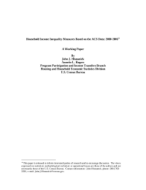
An official website of the United States government
Here’s how you know
Official websites use .gov
A .gov website belongs to an official government organization in the United States.
Secure .gov websites use HTTPS
A lock (
) or https:// means you’ve safely connected to the .gov website. Share sensitive information only on official, secure websites.
-
//
- Census.gov /
- Library /
- Census Working Papers /
- Household Income Inequality Measures Based on the ACS Data: 2000-2005
Household Income Inequality Measures Based on the ACS Data: 2000-2005
Household Income Inequality Measures Based on the ACS Data: 2000-2005
Introduction
While no measure of economic well-being can be all encompassing, income is the measure most commonly used because it affects both the quantity and quality of the goods and services a household can buy. Discussions of household income often involve the issue of income inequality, as well as questions regarding the appropriate metric to measure inequality and whether one measure is preferred over another. The following discussion will focus on several common measures of inequality using household income data from the American Community Survey (ACS) for the years 2000 through 2005.
The inequality measures presented are the Gini coefficient (G), the mean logarithmic deviation of income (MLogD), the Theil index (T), and the Atkinson index (A). These measures were computed nationally, as well as for each state, using the six years of available ACS data. The ACS is intended as a new approach to collecting reliable, timely information on United States (U.S.) households for critical government functions. The ACS is designed to replace the decennial census long form and collects detailed demographic, socioeconomic, and housing statistics traditionally collected in the long form. Fully implemented in 2005, the ACS is the largest household survey in the United States, with a sample size of about 3 million housing unit addresses throughout the country. During the testing program (2000 to 2004), the ACS consisted of a sample of 800,000 addresses per year and produced estimates for the United States, states, and essentially all places, counties, and metropolitan areas with at least 250,000 people. The population represented (the population universe) is limited to the household population and excludes populations living in institutions, college dormitories, and other group quarters.
Others in Series
Working Paper
Working Paper
Working Paper
Share
Some content on this site is available in several different electronic formats. Some of the files may require a plug-in or additional software to view.
 Yes
Yes
 No
NoComments or suggestions?


Top


